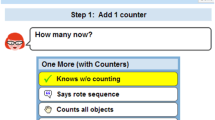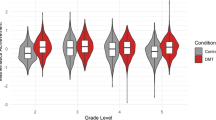Abstract
This evaluation study examined the school achievement and adjustment by at-risk students one year following their participation as fifth and sixth graders in computer-intensive classrooms using the Apple Classrooms of Tomorrow (ACOT) program. Comparisons between the former ACOT subjects and a matched control group who had attended the same elementary school were made on attitudes toward school, teacher evaluations, grades, computer skills, and standardized test scores. Results showed some advantages for the ACOT students in the seventh grade, but on most measures they were indistinguishable from the control group. Specifically, both groups appeared to remain at risk based on their poor performance and relatively poor adjustment. A key factor in interpreting outcomes for the ACOT group was the limited availability of computers in the seventh grade, which thus restricted their opportunities to apply or transfer the skills they had learned.
Similar content being viewed by others
References
Anderson, J., & Kretschmer, J. (1983).Rixrate read-ability program. Oxford, OH: Miami University.
Baker, E. L., Gearhart, M., & Herman, J. L. (1990).The Apple Classrooms of Tomorrow: The 1989 evaluation study. Los Angeles: UCLA Center for Technology Assessment.
Baker, E. L., Herman, J. L., & Gearhart, M. (1988).The Apple Classrooms of Tomorrow: 1988 evaluation study. Los Angeles: UCLA Center for the Study of Evaluation.
Bangert-Drowns, R. L. (1989).Research on word processing and writing instruction. Paper presented at the annual meeting of American Educational Research Association, San Francisco.
Becker, H. J. (1987).The impact of computer use on children's learning: What research has shown and what it has not (Report No. 218). Baltimore, MD: Center for Research on Elementary and Middle Schools, The Johns Hopkins University.
Bork, A. (1987).Learning with personal computers. New York: Harper & Row.
Department of Education [Producer]. (1960).Teaching machines and programmed learning. Duart.
Dwyer, D. C., Ringstaff, C., & Sandholtz, J. (1991). Changes in teachers' beliefs and practices in technology-rich classrooms.Educational Leadership, 48, 45–52.
Evans, E. (1971).Contemporary influences in early childhood education. New York: Holt, Rinehart & Winston.
Fisher, C. W. (1988).The influence of high computer access on schoolwork and student empowerment: An exploratory study of the Nashville ACOT site. Boulder, CO: University of Colorado. (ERIC Document Reproduction Service No. ED 304 100)
Friedman, J. E., & Kephart, D. (1989). Pull-in, reachout: Successfully integrating technology for at-risk students.The Computing Teacher, 17, 12–15.
Gross, B. (1989). Can computer-assisted instruction solve the dropout problem?Educational Leadership, 49–51.
Herrmann, R. W. (1989). Computers in Virginia's public high schools.Computers in Education, 13, 85–93.
Hodges, W., & Smith, L. (1978, August).Retrospect and prospect in early childhood and special education. Paper presented at the annual meeting of the American Psychological Association, Toronto.
Johnson, C., & Ross, S. M. (1989).Integrating computer usage with the teaching of school subjects. Paper presented at the annual meeting of the Mid-South Educational Research Association, Little Rock, AR.
Kitabchi, G. (1987).Final report for the evaluation of the Apple Classroom of Tomorrow Project Phase II. Memphis, TN: Memphis City Schools.
Kitabchi, G. (1988).Final report for the evaluation of the Apple Classroom of Tomorrow Project Phase III. Memphis, TN: Memphis City Schools.
Mecklenburger, J. A. (1990) Educational technology is not enough.Phi Delta Kappan, 72, 104–109.
National Task Force on Educational Technology (1986, August). Transforming American education: Reducing the risk to the nation.T.H.E. Journal, 58–67.
O'Neil, J. (1990). Computer “revolution” on hold.ASCD Update, 32(9), 1–5.
Papert, S. (1980).Mindstorms: Children, computers, and powerful ideas. New York: Basic Books.
Perkins, D. N., & Salomon, G. (1989). Are cognitive skills context bound?Educational Researcher, 18, 16–25.
Perlman, R. (1989). Technology's role in restructuring schools.Electronic Learning, 8, 8–16.
Ricketts, D. (1990). Superintendents say: Much done, much to do.The School Administrator (Special Issue), 10–13.
Ross, S. M., Smith, L. J., Morrison, G. R., & Erickson, A. (1989). Helping at-risk children learn through distance tutoring: The Memphis ACOT program.Technological Horizons in Education, 16, 68–71.
Ross, S. M., Smith, L. J., & Woodson, E. (1991). The development of writing skills in a computer-intensive environment.Journal of Computing in Childhood Education, 2, 3–20.
Rothman, R. (1988, April 1). “Computer competence” still rare among students, assessment finds.Education Week, 200.
Slavin, R. E., & Madden, N. A. (1989, February). What works for students at risk: A research synthesis.Educational Leadership, 4–12.
Suppes, P. (1966). The uses of computers in education.Scientific American, 215, 207–220.
Tierney, R. J. (1988).The engagement of thinking processes: A two year study of selected Apple Classroom of Tomorrow students. Columbus, OH: Ohio State University. (ERIC Document Reproduction Service No. ED 315 061).
Woolfolk, A. (1990).Educational psychology. Englewood Cliffs, NJ: Prentice-Hall.
Author information
Authors and Affiliations
Additional information
This research was supported by a grant from Apple Classrooms of Tomorrow, Apple Computer, Inc.
Rights and permissions
About this article
Cite this article
Ross, S.M., Smith, L.S. & Morrison, G.R. The longitudinal influences of computer-intensive learning experiences on at-risk elementary students. ETR&D 39, 33–46 (1991). https://doi.org/10.1007/BF02296570
Issue Date:
DOI: https://doi.org/10.1007/BF02296570




